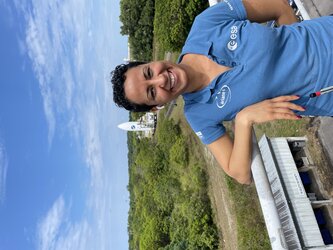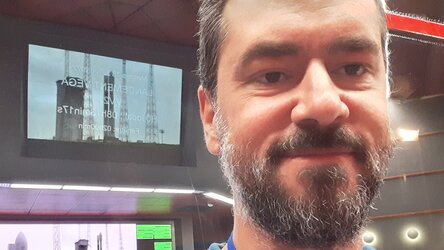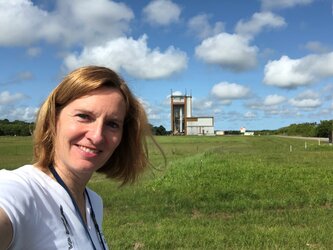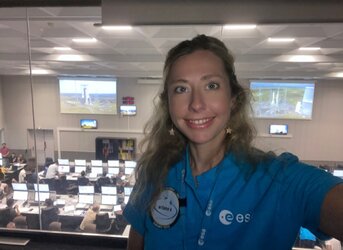Faces of Ariane 6: Michel
It takes thousands of people to design, develop, build and operate a complete launch system to the stars. Here we highlight the people from all over Europe working on space transportation to ensure access to benefits of the wider Universe.
What is your name and role?

I am Michel Bonnet, working for ESA as Head of Ariane 6 missions and system engineering. Generally, this means that I look at the feasibility of future missions, such as missions to the Moon or Mars and how they would fly on Ariane 6. Incidentally, I am also the inaugural flight principal so this upcoming first launch of Ariane 6 is taking up a lot of my time in the last months, but I can rely on the five people in my team that are still working on the future missions.
How long have you been involved in space transport and what were your tasks?
I started my career in a company specialised in acoustics and vibrations in 1985 - I go way back! - working in various fields from nuclear submarines stealth and (conversely) detection to the dynamics of skis, but also in the food sector. After a few years I moved to another company designing critical components, like rotor joints, for helicopters.

I had an opportunity to move to the space world in 1990, joining Aerospatiale to help suppress the sound of Ariane 5 launches at liftoff working with the industrial teams, and then evolving to other functions in system mechanical engineering and environments. I did this until the third flight of Ariane 5 and then moved to help start the Vega programme in Italy near Colleferro near Rome, in Italy, as part of the joint venture Aerospatiale and Fiat Avio, a new prime industrial called Vegaspazio back in 1998. The Vega programme was put on hold one year later and so I returned to France where I joined Starsem to study the adaptation of an Ariane 4 fairing on a Soyuz launcher, that would be bigger than the original Soyuz upper part used at the time. This project never came to being, but I moved to work for France’s space agency CNES as Head of the mechanical, thermal and aerodynamics division.
In 2001 the Vega programme was back up and running and so I returned to work for that rocket, but now I was employed by ESA and based in ESRIN as Head of the mechanical and propulsion engineering. I participated to the first seven Vega launch campaigns that were all a success. In mid-2017 I moved to join the Ariane 5 team, still at ESA. but after just a few months I moved to the Ariane 6 team to help prepare for the inaugural flight and in 2019 took the lead of the Ariane 6 missions and system engineering team.
What is your educational background and prior work experience?
I have built a career based on acoustics and structural dynamics, which is much broader than you might think! It’s not all stealth submarines, helicopters and rockets. In 1986 I worked on a project on how to improve the quality control of some famous French biscuits – the Cracottes - that are known for their cracking sound and crispy consistency when you eat them. At the time the quality control consisted of somebody randomly taking a sample and literally eating them to test their “crackiness and crunchiness”. We developed a mechanical jaw that analysed the sound of the biscuit being eaten, and by analysing the sound spectrum we had a more scientific and measurable way of quantifying what “crunchy” and “crispy” meant. I also worked on skis structural dynamics and various other products.
What is the most notable or memorable moment during your time working on space transport?
The firing tests for the Vega solid rocket motors were done in Sardinia on the east coast, there’s a 5 km by 50 km military test area there. I have fond memories of this time as we left early in the morning with a picknick, did our day’s work and enjoyed a great view of the fabulous landscape while having lunch on the beach. Whatever the season the test team used to conclude the firing test with a dip in the sea. The only disadvantage for us was that the test area was closed during summer holidays as we were not allowed to interrupt tourist season with our (loud) tests.


Access the video

What does it mean to you to be part of the larger team of rocket scientists and engineers?
Who doesn’t dream of working in space as a kid? As such I am grateful to have found my place. I made home-made rockets as a kid in the backyard until one went wrong and exploded in the garden of our neighbours and I was told to stop, well I managed to continue, and get paid for it.
Actually, as an adolescent my career path was to be a butcher, so I don’t have a specific space background at all but did switch from aspiring to be a butcher to be an engineer. I studied in Lille, France, and the first company that took me after my studies was a company in Lyon, France, where I started in acoustics and structural dynamics.
I am very happy to have had the opportunity to join the space domain, and I never had any problem getting up in the morning to go to work. Not everybody can say that, so I feel blessed, for sure.

What is one thing you’d like the European public to know about your job?
I would like people to realise that in a career you have to seize the opportunity and don’t hesitate to move geographically, company or even domain. It helped me get to where I am now and allowed me to develop skills in many different areas.
What’s the best thing about your job?
The diversity is amazing, to work on missions that are far in the future, but also to work on the now, what we are doing today during this interview is moving the Ariane 6 central core to the launchpad, this hardware will fly this year!
But looking back, having worked on Ariane 5, Soyuz, Vega and Ariane 6, I am privileged.
What do you do outside of your job to unwind, what are your hobbies, what do you do for fun?
I love DIY at the house and make furniture. I like travelling, like many people. I love objects with history, collecting old objects, that I pick up from French ‘brocantes’ second-hand markets. Before throwing anything away I will take it apart and keep any objects that I might need in the future. I have so many boxes of parts and objects that I hope to use in a different way, someday, sometime in the future.
Do you have any advice for future generations interested in space exploration?
Don’t be worried to not be an expert, just go and learn on the job, you will have a great career. I didn’t study at the best aerospace school, but by seizing the opportunity and working hard you can work yourself up to where you want to be.












